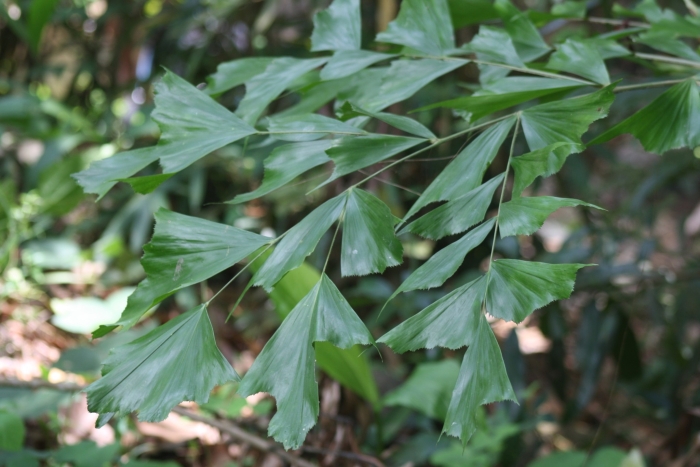Jaggery Palm
(Caryota urens)
Jaggery Palm (Caryota urens)
/
/

Manoj Karingamadathil
CC BY-SA 4.0
Image By:
Manoj Karingamadathil
Recorded By:
Copyright:
CC BY-SA 4.0
Copyright Notice:
Photo by: Manoj Karingamadathil | License Type: CC BY-SA 4.0 | License URL: http://creativecommons.org/licenses/by-sa/4.0/ | Rights Holder: Manoj Karingamadathil | Publisher: iNaturalist | Date Created: 2016-05-26T12:34:22-07:00 |
















































Estimated Native Range
Summary
Caryota urens, commonly known as Jaggery Palm, is an evergreen tree native to the rainforests and moist deciduous forests of India and Sri Lanka to Myanmar. It can reach up to 15 m (49 ft) in height and has a trunk up to 30 cm (12 in) in diameter. The bipinnate leaves are dramatic and large, up to 6 m (20 ft) long, with leaflets shaped like fishtails, giving rise to another common name, Fishtail Palm. The 3 m (9.8 ft) long inflorescences are sequentially produced at each leaf node, from top to bottom, and bear pendent clusters of white, unisexual flowers. The fruit matures to a round, 1 cm (0.39 in) drupe, red in color with one seed. As with all Caryotas, the fruit contains oxalic acid, which is a skin and membrane irritant. Caryota urens is monocarpic, meaning that after it flowers and fruits, the individual stem dies.
Jaggery Palm is valued for its striking foliage and architectural form, making it a popular choice for ornamental use in gardens, parks, and as a focal point in tropical and sub-tropical landscapes. It requires well-draining soil, moderate watering, and can tolerate both full sun and part shade. While it is relatively low-maintenance, it is important to handle with care due to the irritant nature of its fruit. In cultivation, it is also used for the production of jaggery, a type of sugar, and for its sap, which can be fermented to produce an alcoholic beverage. However, it is potentially invasive in some regions, so it is crucial to check local regulations before planting.CC BY-SA 4.0
Jaggery Palm is valued for its striking foliage and architectural form, making it a popular choice for ornamental use in gardens, parks, and as a focal point in tropical and sub-tropical landscapes. It requires well-draining soil, moderate watering, and can tolerate both full sun and part shade. While it is relatively low-maintenance, it is important to handle with care due to the irritant nature of its fruit. In cultivation, it is also used for the production of jaggery, a type of sugar, and for its sap, which can be fermented to produce an alcoholic beverage. However, it is potentially invasive in some regions, so it is crucial to check local regulations before planting.CC BY-SA 4.0
Plant Description
- Plant Type: Tree
- Height: 35-49 feet
- Width: 10-35 feet
- Growth Rate: Moderate
- Flower Color: White
- Flowering Season: Summer
- Leaf Retention: Evergreen
Growth Requirements
- Sun: Full Sun
- Water: Medium
- Drainage: Slow, Medium, Fast
Common Uses
Edible*Disclaimer: Easyscape's listed plant edibility is for informational use. Always verify the safety and proper identification of any plant before consumption., Low Maintenance
Natural Habitat
native to the rainforests and moist deciduous forests of India and Sri Lanka to Myanmar
Other Names
Common Names: Sago Palm, Solitary Fishtail Palm, Wine Palm, Toddy Palm, Fishtail Palm, Kitul-Tree, Brennpalme, Kitulpalme, Sagopalme, Fischschwanzpalme
Scientific Names: , Caryota urens,
GBIF Accepted Name: Caryota urens L.